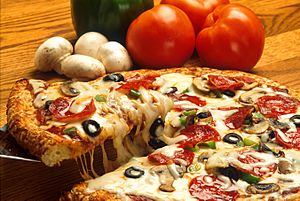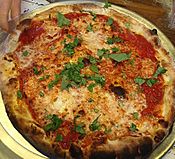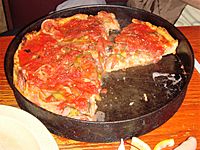Italian-American cuisine facts for kids
Italian-American cuisine is a special kind of Italian cuisine that grew and changed in the United States. It was created by many waves of Italian Americans who moved to the U.S. over time.
When immigrants from different parts of Italy came to America, they brought their unique cooking styles. Many of these foods and recipes became new favorites for people in their towns. Eventually, they became popular all across America.
Famous chefs like Giada De Laurentiis and Mario Batali have helped make Italian-American food well-known.
Contents
How Italian-American Food Started
Most Italian-American food comes from the cooking traditions of Southern Italy. Many immigrants from places like Naples and Sicily arrived in the late 1800s and early 1900s. They settled in big cities like New York City, Philadelphia, and Chicago. Because of this, much of the food is based on Neapolitan and Sicilian dishes.
Italian-Americans often connect their food to the region their families came from. In Southern Italy, people often ate pasta, tomato sauce, and olive oil. In Northern Italy, popular foods included risotto (a creamy rice dish), white sauce, and polenta (a dish made from cornmeal).
Over time, Americans started to appreciate Italian food more. Also, more ingredients from Italy became available. This led to a desire for more "authentic" Italian dishes, using traditional cooking methods and ingredients.
Some Italian foods like espresso (a strong coffee), tiramisu (a layered dessert), and Nutella (a chocolate-hazelnut spread) became very popular in America. Interestingly, a pasta dish called pasta alla carbonara might have even been influenced by Americans during World War II. Italians used ingredients like powdered eggs and bacon supplied by American soldiers to make new pasta dishes.
Why Italian-American Food is Popular
Italian-American food is very popular in the American diet. It's one of the top three cuisines in the United States.
According to the National Restaurant Association, Italian, Mexican, and Chinese foods are now very common in America. Most people know about these foods and have tried them. About half of Americans eat them often!
Some popular Italian-American items include Mediterranean flatbread, ciabatta bread, espresso, tiramisu, and Nutella. Pizza and pasta are also very common. However, they are often made differently in America than in Italy.
Italian-American Food and Wine
There's a strong link between Italian-American food and the history of winemaking in the United States.
Italian wines first came to the U.S. in the late 1700s. Italian winemakers helped grow grapes in places like Florida. Later, many Italian immigrants came to America between the 1870s and 1920s. Many arrived on the East Coast through Ellis Island and then moved to places like California, especially during the Gold Rush.
In California, Italian-Americans were inspired by the beautiful hills and rich fields. Before Prohibition (a time when making and selling alcohol was against the law) started in 1919, many wineries were founded by Italian-Americans. Some of these, like Seghesio and Simi, are still making wine today.
During Prohibition (1919-1933), many Italian-Americans struggled to keep their vineyards. Some survived by making wine for the Catholic Church or selling grape juice. These people helped save America's winemaking tradition.
Today, Italian-American wineries are very important in the world wine market. Companies like E & J Gallo Winery and Robert Mondavi are well-known. Italian-Americans enjoy many types of wines, from California wine to imported Italian wine like Chianti.
Popular Dishes
Pastas and Grains
- American chop suey—This dish is a bit like a meat sauce with pasta, often using hamburger meat.
- Baked ziti—A type of tube-shaped pasta, baked with tomato sauce and lots of cheese.
- Lasagna—Layers of pasta, sauce, and cheese. In America, it often uses ricotta cheese, which is different from the traditional Italian version that uses a white sauce.
- Penne alla vodka—Pasta with a creamy sauce made from tomato, onion, prosciutto (a type of ham), cream, and a touch of vodka.
- Polenta—A dish made from cornmeal, often served with cheese or butter, and sometimes with a meat sauce.
- Spaghetti and meatballs—A very famous American dish! It's based on Italian festival foods, but in Italy, the meatballs are usually much smaller.
Vegetable Dishes
- Eggplant parmesan—Layers of sliced eggplant, marinara sauce, and cheese, baked until bubbly. In Italy, it's not served with spaghetti.
- Peas and eggs (piselli cacio e uova)—A simple dish of eggs and peas fried with olive oil, garlic, onion, and pepper. It was a common meal for poor immigrants and is now a favorite during Lent.
Meats and Eggs
- Frittata—Like an open-faced omelette, it can have meat, cheese, potatoes, peas, or other vegetables. It can be eaten alone or in sandwiches.
- Sausage and peppers—Sausage, bell peppers, and onions cooked together, sometimes with a light red sauce.
- Porchetta—Italian roast pork, often served in a sandwich, especially in Philadelphia. It's a traditional holiday or festival dish.
- Chicken (or Veal) Parmesan—Fried chicken or veal cutlets covered in sauce and cheese, usually served with pasta. It's often called "parm."
- Chicken marsala—Chicken cutlets cooked with mushrooms and Marsala wine.
- Chicken Francese—This dish was created by Italian-American restaurant owners after World War II when French food became popular.
Sauces
- Alfredo sauce—In America, this creamy sauce is made with cream, butter, and Parmigiano-Reggiano cheese. It's served over pasta, vegetables, or meats. The original Italian Alfredo is much simpler, just pasta, butter, and cheese.
- Marinara sauce—A quick-cooking tomato sauce without meat, often a little spicy, served on pasta.
- Bolognese sauce—A meat-based sauce that comes from Bologna, Italy.
- Sunday sauce—A rich tomato sauce with meat, often cooked for a long time on Sundays or special days. In some areas, it's called "gravy."
Seafood Dishes
- Lobster Fra Diavolo—A spicy pasta dish with lobster and sometimes other seafood, made with crushed red pepper.
- Baccalà—Salted cod fish, traditionally eaten during Lent or on Christmas Eve. It can be fried or made into a salad.
- Alici or Acciughe—A dish of spaghetti with garlic, olive oil, and anchovies, often eaten on Christmas Eve. The anchovies and garlic melt into the oil.
Soups and Stews
- Cioppino—A fish stew popular among Italian-Americans on the West Coast, especially in San Francisco.
- Wedding soup—A soup with small meatballs or sausage and pasta in a chicken broth.
- Pasta e fagioli—Pasta with beans, often cannellini beans, that has a thick, stew-like texture.
Breads, Sandwiches, and Savory Baked Goods
- Calzone and stromboli—A calzone is a half-moon shaped pastry filled with cheese and other ingredients. A stromboli is similar but shaped like a roll or loaf.
- Italian bread—American "Italian bread" is a white bread, often braided and covered in sesame seeds. It has a thin, crisp crust and soft inside. It's very popular for sandwiches.
- Pizza—The most common American pizza is based on the Neapolitan style, often called New York-style pizza. Sicilian pizza, which is thicker and square, is also popular. More American versions like Chicago-style pizza are also common.
- Submarine sandwich—A long sandwich filled with various meats, cheeses, and vegetables. It started in Italian-American communities in the Northeastern U.S.
- Muffuletta—A large round sandwich with cold cuts and olive salad, from New Orleans.
- Italian beef sandwich—A roast beef sandwich from Chicago, similar to a French dip.
- Meatball sandwich—A sandwich filled with meatballs and sauce.
- Pizzagaina or pizza rustica—An Easter pie made with cheeses, eggs, and salted meats.
Sweets
- Tiramisu—A sweet, multi-layered cake with light, creamy filling, often served with coffee. It's a more recent Italian dessert that became very popular in America.
- Cannoli—A sweet ricotta cheese filling inside a crispy, fried pastry shell.
- Struffoli—Small, fried dough balls often covered in honey, typical for Christmas in Naples.
- Biscotti d'annodare—Knot cookies.
- Sfogliatelle—A pastry with many thin layers, often filled with a sweet cream.
- Biscotti—Hard, crunchy cookies, usually flavored with anise or vanilla, and often containing nuts or dried fruit. Americans often dip them in coffee.
- Pizzelle—Thin, crispy waffle cookies, usually flavored with anise or lemon. They are popular during Christmas among Italian-Americans, especially in Philadelphia.
See also
 In Spanish: Gastronomía italoestadounidense para niños
In Spanish: Gastronomía italoestadounidense para niños





